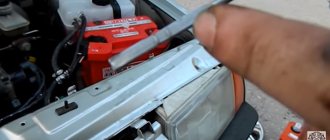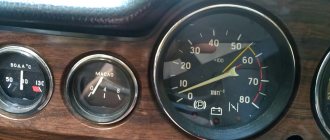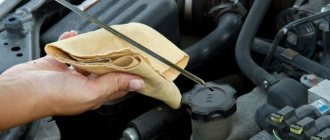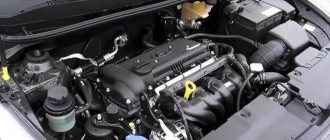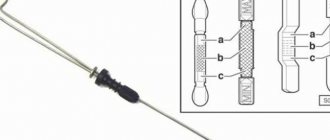Replacement with five-minute flushing
The method differs from the simplest one in that before draining the old oil, we first add “five minutes”, after which we run the engine according to the instructions, and only then drain the oil along with flushing.
- Advantage: flushing should dissolve a larger amount of deposits compared to the classic “drain and fill” operation.
- The main disadvantage: part of the flushing product will inevitably remain in the non-drained residue, mixing with fresh oil. In addition, the cost of purchasing flushing is added.
What is needed for draining and replacement
The optimal place for this procedure is a garage equipped with an inspection hole or, at worst, an overpass. If there are no such possibilities, you can do without a hole, the main thing is to choose a clean and dry place with a curb or hill that will allow you to raise the car a little. As a last resort, you can jack up the car, but do not forget to put it on the handbrake.
The most important thing when performing the above actions is to carefully follow safety precautions. Under no circumstances should the car roll; it must be securely secured!
Now I’ll show you what happens if you don’t do this.
Before installing the jack, it is a good idea to look under the car to determine where the drain plug is located and which of the front wheels needs to be lifted to drain or pump out used engine lubricant. Now you need to worry about finding a suitable container for removing used grease. To drain the excess, any old basin, enamel or plastic, will do. You also need to prepare a 5-6 liter container of mineral water into which you can pour the oil for its subsequent disposal.
You will need certain equipment and tools. You need to select a head of the appropriate diameter for the drain plug. To remove the filter, you should purchase a special puller from auto shops that can be used to tear off the filter by wrapping it tightly. Be sure to prepare several rags: place some under the filter, others can be used to wipe the dipstick dry. Any cut plastic bottle can be used as a funnel to drain excess oil.
Replacement with pneumatic cleaning
A relatively new service offered by some car services. An oil change device with an engine pneumatic cleaning function, developed by the American company BG, involves the following replacement steps:
- Drain the oil from the pan, connect the installation fitting to the lubrication system channel at the outlet of the oil filter. Use compressed air to squeeze out the remaining old oil.
- We remove waste residues from the pallet.
- We fill the lubrication system lines with fresh oil. This speeds up the supply of lubricant after starting the engine and eliminates dry operation.
- We install a new oil filter.
- Add oil to the engine through the neck to the required level.
There is no need for such a procedure if the engine is relatively young and its oil has been regularly changed according to the regulations. And if a car owner is so sensitive to his car that he changes the oil at half the mileage (relative to the regulations), then pneumatic cleaning makes no sense at all.
Draining oil through the dipstick
Also, the oil from the engine can not be drained, but pumped out. To do this, you need to find the oil dipstick under the hood of the car, which is removed, and a tube is inserted in its place, and a hardware installation for pumping oil through the dipstick .
You also need to know how to use the oil pump itself and have a compressor. One wrong move and everything around you will end up in oil.
Therefore, when changing engine oil, it is better to use a traditional drain. The only exception is when engine oil has been poured into the engine. In this case, you can pump out the excess. But it’s better not to overfill initially, but gradually add to the level...
Unfortunately, you can sometimes find advice on the Internet to suck out excess oil from the neck with your own mouth. Under no circumstances should you do this! This is very dangerous for your health! The chemical liquid contains many toxic substances. Therefore, even a small amount entering the human body can lead to severe poisoning. Often, its consequences can only be dealt with in a hospital setting.
In addition, you should not try to drain the oil on the street, especially in the courtyard of an apartment building. The neighbors will be clearly unhappy with oil puddles on the road or lawn.
How to change engine oil correctly
All car enthusiasts change their engine oil - that's a fact. But two experienced motorists can change the oil at different car mileages, as well as different types of oil and companies. Try, for the sake of experiment, to raise the question of how to properly change the oil in a car engine on any forum and you will get a heated discussion. Many also wonder whether to drain the oil or pump it out. We adhere to the fact that the oil must drain from the neck and the latter must be in the correct position.
All motorists need to remember that the main property of oil is its detergent property. If you drove 2 thousand km, checked the oil, and it was clean, checked it at 5 thousand km - it was clean, and at 10 thousand km - it was clean. Change the oil immediately, it simply does not clean the engine. The oil must drain the deposits that appear in the engine. But if the oil very quickly turns into grease, this is of course bad.
We can only advise what we do ourselves. Before draining the oil, we recommend driving out onto the highway and giving the car high revs and high speed. And then immediately go to a service station or garage and drain the oil. It is also best to place the car on a lift so that the oil drain neck is at its lowest point, so that as much as possible all the oil drains out of the crankcase.
Here is our plug, unscrew it and drain the oil.
Everyone has probably seen what kind of deposits there are in an engine. These are exactly the deposits that occur when you fill in oil that does not clean the engine well. In our understanding, the cleaning function of oil is no less important than the lubricating function.
If the oil does not lubricate, scuffing will appear in the engine, and if the oil does not wash, the engine will coke and become unusable. It is also necessary to say about the cooling function of the oil - it is very important. This is the black oil we drained from the engine.
After draining the oil, we make 2-3 clicks with the starter. After this, more oil that was in the oil pump is poured out. In our opinion, this is an effective method. Ideally, leave the car like this overnight. Something will come together.
Before adding new oil, it is best to pour 300 to 500 grams of fresh new oil into the system with the drain plug open. What will we achieve with this? The oil, flowing down the head, along the walls of the engine, and along the crankcase, washes away deposits that the previous oil had picked up but was able to carry along with it.
Regarding whether it is necessary to fill the filter with oil. Some say that it is necessary and that this is how we make the work of the oil pump easier. Others say that it is useless and that the oil will run through on its own. We are inclined to believe that oil should be poured into the filter.
You should always lubricate the rubber band on the filter.
We rinse the engine with fresh oil on the unscrewed cover. We can say that we change the engine oil with flushing, but with new oil, not kerosene and so on. Watch a video on how to properly change the oil in a car engine at the end of the article.
We filled in new oil, but look how black it drains as a result.
Well, the last thing is to tighten the plug, but not overdo it.
In this way, you can change the engine oil as in VAZ cars: 2108, 2109, 2110 and newer and older models, as well as in foreign cars, as in our case Fiat. Whether or not to adhere to our advice is up to you to decide. And our task is to share interesting tips with you.
Draining oil from the engine: photos and videos
Many car enthusiasts have wondered how to drain oil from the engine. This is done for different reasons and with different intentions. Of course, it is worth understanding that not all motorists are capable of not only draining the oil, but even finding the oil level (dipstick) on the power unit. So, the article will tell you how to drain the lubricating fluid from an internal combustion engine and for what purpose this is done.
How to drain excess oil from the engine?
It would seem that the answer is on the surface (more precisely, under the bottom). Open the plug, drain the oil, and fill it back in a smaller quantity. From a technical point of view, this is the right decision, but draining the lubricant while keeping it clean will not work. Therefore, we remember this method as a last resort and never use it. In general, just drain the excess, not all the oil.
Another option from the treasury of garage craftsmen (nevertheless, tested in practice) is draining the oil filter. If you tilt the car strongly (driving onto a curb) in the direction opposite to the location of the filter, you can easily unscrew it and pour out the liquid. Up to 200 ml of oil is placed in the filter jar. Then carefully put it in place.
The method is not suitable for all cars. In addition, there is a small risk of contamination.
class=”eliadunit”>
The excess oil is carefully drained through the plug on the crankcase. Just don't turn it off completely. It is enough to unscrew to the middle of the thread, and the oil will begin to flow out in a thin stream. The method requires patience, but it is effective and safe for the engine.
Conclusion
In many cases of vehicle operation, it may be necessary to drain the oil from the internal combustion engine. Of course, not a single manufacturer recommends carrying out this process yourself, but only at a car service center. Still, car enthusiasts do everything themselves, with their own hands, to avoid additional waste, since the pricing policy of most car services leaves much to be desired.
At the same time, we should not forget that incorrectly replacing the lubricant will entail a lot of troubles, so it is better to pay extra for a replacement than to “end up” with a major overhaul of the “heart” of the machine.
Source
How to pump oil out of the engine if draining is impossible?
The only possible way is a vacuum pump. But these are only available at service stations; to use them in the garage, you will have to shell out a tidy sum. You will have to pump it out through the dipstick; the oil filler neck is not suitable for this.
You can make something like a vacuum pump yourself:
- From a pastry syringe. The pressure is low, but the volume is good. You can pump out 200-300 ml in one go.
- From a medical syringe. The situation is the opposite: excellent pressure, but small volume.
- From a rubber syringe or PET bottle with thick walls. If the container is compressed, back pressure is created when the shape is restored.
Why do you need flushing when replacing?
It is best to use flushing oil specifically designed for cleaning the engine.
It looks like this: once you have removed as much of the old lubricant as possible, fill in the flushing oil and let the engine run with it for about 20 minutes. Having determined how much oil remains in the system, remove it and only then fill in a completely new one. In this way, the presence of deposits and metal particles inside the engine can be minimized. However, the use of so-called “long rinses” is considered more effective. These are special means on which the car must travel up to 200 kilometers. According to the results of studies, such products efficiently remove old deposits without destroying, at the same time, the beneficial characteristics of fresh oil. It is especially recommended to use this procedure in cases where you had to drive for a long time on the old lubricant, that is, there was actually an overrun. The same applies if mineral oil was previously poured into the car, and then the owner decided to switch it to synthetic.
No other oil change tool is required. However, it is necessary to know the exact volume of the lubrication system. Since most modern passenger car engines can accommodate from 3.5 to 5 liters, it is better to clarify this data in the operating instructions prepared by the manufacturer. Therefore, observe the readings of the pressure indicator, and also take several control measurements using a dipstick after replacement.
Friends, I hope that after reading this material, you will have enough theoretical skills on how to drain used oil from an engine. All that remains is to consolidate this with practical experience. Meet us on the pages of new materials and review articles. Read my blog and see you soon!
Source
Consequences of mixing different types of oils
As you know, there are cases when draining the oil from the engine is necessary even before the power unit has started after maintenance. This could be an accident or simple negligence. This situation is called mixing different types of lubricating fluid. So, why do you need to drain the oil from the engine? - the answer to the question is quite simple:
Of course, there are other reasons and consequences of mixing different types of lubricating fluids, which will require draining the oil from the main power unit.
